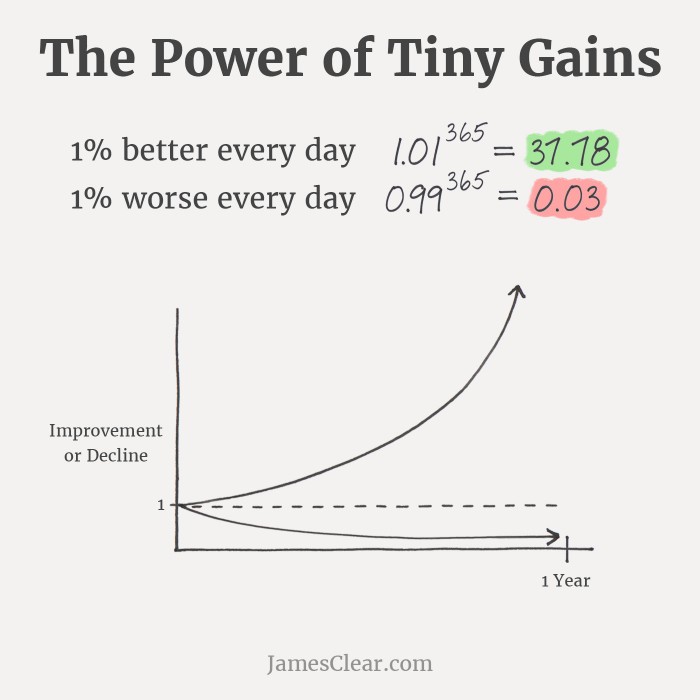Tighten The Feedback Loop
Preface
This is the third segment of a 4-part manifesto about the product I’m building.
I’m sharing it here because the fundamental principles are relevant to anyone interested in crafting an intentional life.
You can read the other parts here:
- (Part 1) Bias Towards Action
- (Part 2) Failure Is An Opportunity
- (Part 4) Habit Gym
Compounding Is Powerful
In a previous post about inertia, I discussed how habits have momentum. Once a habit is established, it’s easy to maintain and results in continued progress. When it breaks, it requires effort to restart and leads to atrophy.
Compounding exacerbates this effect. It’s a powerful accelerant in either direction. A 1% improvement every day makes you 37.8 times better in a year. A 1% decline every day makes you 97% worse in a year.
Slow And Steady Wins The Race
What makes compounding so effective is that progress builds on itself. As your foundation grows, so do your incremental gains. It starts slow, but grows exponentially. Compare the impact between a one-shot 365% improvement and a 1% improvement every day for a year. The difference is an order of magnitude: 3.65x vs 37.8x!

The lesson is clear: small changes add up. Incremental improvements are better than sporadic bursts of progress. They are more sustainable and more effective. To put it another way: slow and steady wins the race.
Tighten The Feedback Loop
Feedback loops exemplify this principle. They allow you to harness the power of compounding through a virtuous cycle - results feed back into the system to generate even greater returns. The tighter this loop, the faster it compounds.
When crafting an intentional life, it’s especially important to tighten the feedback loop between action and reflection. Action is to “crafting” as reflection is to “intentional”. These were the respective topics of my last two posts.
In Bias Towards Action, I urged the prioritization of action as the only path to real-life improvements.
Action is the interface between thought space and the real world - we actualize our ideas by doing. Knowledge is merely potential energy. Only when applied, does it translate to growth.
In Failure Is An Opportunity, I extolled the virtues of reflection in extracting valuable insights from inevitable failures.
Failure is the opportunity to learn how to adapt. By exposing your weaknesses, it provides a blueprint for action. Only when you understand what went wrong can you put a plan in place to address it. The obstacle is the way - your mistake reveals its respective intervention.
In this post, I show how action and reflection form a virtuous cycle:
- You act in order to manifest change.
- You reflect on how to adapt.
- [Failure] How do I succeed next time?
- [Success] How do I do even better next time?
- You act with greater effectiveness.
- Repeat!
As you tighten this feedback loop, your progress accelerates. All you have to do is be consistent - compounding will take care of the rest.
Building It Into The Product
I incorporate the ‘Tighten The Feedback Loop’ principle in my product by holding users accountable to weekly reflections. This is done through financial accountability - if they fail to submit a regular check-in, they are charged a penalty to charity (not me).
This is better than existing accountability platforms for two reasons.
First, they charge you the penalty if you fail to hit your goal. However, failure is inevitable. By penalizing failure, they penalize trying. My solution: I only require users to reflect every week; not to hit their goal. This way, they embrace failure instead of fearing it.
Second, they have misaligned incentives. Their business model is to take a cut of your penalty. They only make money when you fail. My solution: users are charged to charity (not me) if they fail. They pay me for the service only when they have completed a program and witnessed the results. As a result, I only make money if they succeed.
Sound vague or simplistic? Stay tuned - it all comes together with the remaining segments of the series!
–
This post took redacted minutes to write.
Here’s why I share this data with my email list. Join us!
P.S: You can find more of my thoughts on Twitter @_suketk.